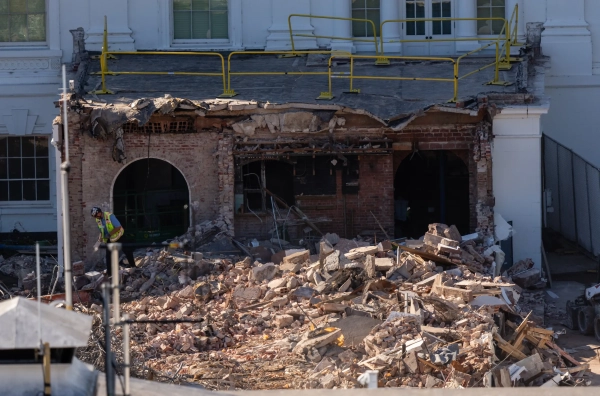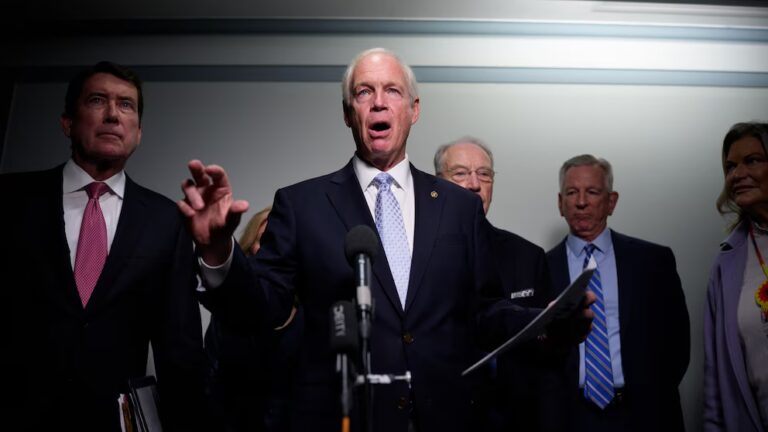“`html 
President Donald Trump has razed the East Wing of the White House to accommodate his proposed $300 million ballroom.
It took merely a few days, from beginning to end, to dismantle the more than century-old construction, originally erected in 1902 and substantially refurbished and enlarged in 1942. As of Thursday, it’s entirely gone. This has, understandably, prompted some inquiries. Foremost among them: Is this permissible?
Vox has compiled a selection of those inquiries below, and endeavored to address them to the best of our ability. Here’s the information we have:
What is the cause of this?
Trump desires a ballroom on the White House grounds, as part of his endeavor to gradually transform the People’s House into a Mar-a-Lago-esque venue (previous highlights encompass the paving of the historic Rose Garden with a patio that he has christened the Rose Garden Club, the gilding of the Oval Office from top to bottom, and the installation of a pair of 88-foot flagstaffs on each lawn of the White House).
Related
- Trump isn’t merely renovating the White House. He’s redefining America.
All such alterations move the White House in the direction of the ambiance of Trump’s oceanfront Florida resort. As an example, in 2006, he contested the town of Palm Beach regarding his choice to install an 80-foot flagpole of similar dimensions at Mar-a-Lago.
The ballroom, specifically, has been a long-standing preoccupation for Trump, one that existed before his time in office. In 2010, accounts suggest that he contacted the Obama White House about constructing a comparable edifice, but the proposition ultimately led nowhere.
Did we anticipate that this would occur?
In general, no. The formal White House declaration of the ballroom endeavor, in July, suggested that the East Wing might be at risk, stating, “The location for the new ballroom will be the site where the East Wing, which has undergone small, substantial alterations and reconstruction, presently stands.” However, Trump himself conveyed to the press that the new ballroom “won’t impinge on the current structure.”
“It’ll be situated close by but not in contact,” he remarked in July. “And it will show complete reverence for the existing structure, of which I am the foremost admirer.”
Even as late as this week, as activity began on the East Wing frontage, the full extent of the demolition remained uncertain; the strategy to annihilate the entirety of the building was verified only on Wednesday, fewer than 24 hours prior to its completion.
This story was first featured in the Today, Explained newsletter
Comprehend the world with a daily explanation coupled with the most captivating narratives of the day. Subscribe here.
The sudden demolition bears a strong resemblance to an incident from Trump’s early career, during the construction of Trump Tower on Manhattan’s Fifth Avenue. In order to achieve this, he brought down the existing Bonwit Teller building, including a pair of esteemed Art Deco statues positioned high on its outer wall.
Trump had stated earlier that he might gift those bas-relief figures to the Metropolitan Museum of Art, which had expressed a desire to showcase them. Instead, he caught museum representatives off guard by reducing them to fragments with jackhammers, falsely asserting under the alias of “John Baron” that the pieces were “lacking in artistic worth.” (Museum personnel and other specialists disagreed.)
Is this within the bounds of the law?
As is the case with a great many actions by Trump, the legality remains doubtful at best — yet it’s equally indistinct as to who possessed the authority to halt him. There exist at least two entities, the National Capital Planning Commission (NCPC) and the Commission of Fine Arts, that typically engage in modifications to the White House. Presently, both are non-operational as a result of the government shutdown, and neither has had an opportunity to contribute their assessment.
The White House has also asserted that a submission to the NCPC is only mandated “for upward construction,” as opposed to demolition, although a former committee chairperson informed the Washington Post on Wednesday that this has not historically been the practice. The NCPC indicates it will scrutinize the ballroom strategy before its construction, but it is already too late to preserve the East Wing. Furthermore, the board is currently under the control of Trump’s associates — its chairperson, Will Scharf, is also serving as a White House staff secretary — rendering it unlikely that they would impede his strategies.
Ultimately, the demolition may prove to be an issue of custom more so than legal principle. It is challenging to conceive of another president acting with such haste and secrecy to bulldoze a segment of America’s most iconic structure, especially during a government closure when federal workers are not receiving remuneration and funding for vital food assistance programs is bordering on depletion.
Who is assuming the expense?
The Trump administration maintains that the construction of the new ballroom, including the East Wing’s dismantling, will be funded by private donations, alongside supplementary resources. Trump himself has declared his intention to contribute, although it remains to be seen whether he will honor that pledge.
Trump has advocated this approach — which he also employed to finance the Rose Garden patio and the flagpoles — as an advantage, communicating on Truth Social that the ballroom would be erected at “no expense to the American Taxpayer.” While this may transpire to be factual, it is not without its drawbacks: There exist apparent ethical quandaries linked to private benefactors financing a president’s cherished initiative, which become exceedingly discernible upon inspecting the benefactor directory disclosed by the White House on Thursday, which features significant US tech corporations such as Amazon, Apple, and Google, as well as individuals such as crypto magnates Cameron and Tyler Winklevoss.
In recent times, earlier changes to the White House have generally been either strictly essential or substantially more restrained.
Many of the aforementioned contributors hold business interests impacted by the Trump administration, such as Apple’s apprehensions concerning semiconductor tariffs; considering Trump’s temperamental tariff strategy to date, it is not difficult to perceive how a contribution — or failure thereof — could influence his stance. As per remarks made by ethics authority and Penn Carey Law professor Claire Finkelstein to the Wall Street Journal pertaining to a fundraising gala for the ballroom: “Each company extended an invitation to the gala that either declines attendance or fails to donate is now aware that they will forfeit favor with the Trump administration.”
Moreover, private funding facilitates events such as the rapid demolition of the East Wing to take place; under typical circumstances, a presidential administration would be obliged to procure funding from Congress for considerable renovations to the White House, a procedure that would unfold in the public domain.
How extraordinary is it for a president to institute this type of modification to the White House?
This represents one of the administration’s primary justifications for the East Wing demolition: They are simply doing as any other president might. “There have been numerous presidents historically who have left their imprint on this beautiful White House complex,” White House press secretary Karoline Leavitt stated to reporters on Thursday.
While the remark is factually correct — the White House constitutes a consistently progressing and adapting edifice that must remain current with technological advancements and the mandates of the presidency — it circumvents the essence that detractors of the demolition are endeavoring to convey. In recent times, earlier changes to the White House have generally been either strictly essential or substantially more restrained; the most truly extensive alteration transpired under President Harry Truman, and that was because the first family was quite literally susceptible to falling through the White House floor: One leg of a piano owned by Truman’s daughter, Margaret, did in fact rupture the floor.
The Truman refurbishment, which necessitated the first family relocating to the adjacent Blair House for a span of years, essentially entailed a thorough stripping and renovation of the residence. Nevertheless, even in that instance, the building’s outer walls were conserved, outwardly preserving its historic visage.
Since that period, modifications to the White House have been of a lesser scale, encompassing the additions of a bowling lane and a swimming pool, alongside multiple updates to the White House Situation Room located beneath the complex.
How long will the construction of the ballroom require before completion?
Trump’s second and terminal term in office will lapse on January 20, 2029. As is conceivable, he aspires to utilize it in advance. The White House announcement in July indicated that the ballroom would be “finalized well in advance of the cessation of President Trump’s term,” although no precise date has been established.
“`
Source: vox.com






